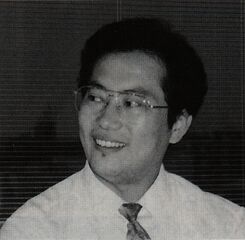Difference between revisions of "Taku Matsubara"
From Sega Retro
m (Text replacement - "= | company=Sega of Japan |" to "= | employment={{Employment | company=Sega of Japan }} |") |
|||
| (2 intermediate revisions by 2 users not shown) | |||
| Line 5: | Line 5: | ||
| dod= | | dod= | ||
| employment={{Employment | | employment={{Employment | ||
| − | | company=[[Sega | + | | company=[[Sega Enterprises, Ltd.|Sega Enterprises]] |
}} | }} | ||
| role=Engineer | | role=Engineer | ||
| Line 18: | Line 18: | ||
==Production history== | ==Production history== | ||
{{ProductionHistory|Taku Matsubara|T. Matsubara|松原 拓}} | {{ProductionHistory|Taku Matsubara|T. Matsubara|松原 拓}} | ||
| + | [[Category:Uncredited role]] | ||
[[Category:Use ProductionHistory template]] | [[Category:Use ProductionHistory template]] | ||
| − | + | ||
*''[[Space Harrier]]'' (1985) | *''[[Space Harrier]]'' (1985) | ||
| − | |||
| − | |||
| − | |||
*''[[Sega Kara]]'' (1994) | *''[[Sega Kara]]'' (1994) | ||
| − | |||
| − | |||
==Photographs== | ==Photographs== | ||
Latest revision as of 04:38, 6 December 2023

|
| Taku Matsubara |
|---|
| Employment history: |
| Role(s): Engineer |
This short article is in need of work. You can help Sega Retro by adding to it.
Taku Matsubara (松原 拓) is a Japanese engineer and developer. His first known work for Sega is engineering the motor drive circuit used in Space Harrier;[1] following this, he switched to console R&D, and was among the team of seven led by Hideki Sato in the development of the Mega Drive.[2]
His involvement with the Mega Drive subsequently saw him develop the Mega CD and 32X.[2] Matsubara also contributed to Sega's karaoke business, designing aspects of Sega Kara.[1] After work on the Dreamcast GD-ROM drive in 1998, he received credits for Sonic Adventure and Rent A Hero No. 1.
Matsubara has more recently been a representative of TM Appliance.[1]
Production history
- Sonic Adventure (Dreamcast; 1998) — Hardware support
- Rent A Hero No.1 (Dreamcast; 2000) — スペシャルサンクス (as 松原 拓)
Hardware
- Sega Mega Drive (Mega Drive; 1988)
- Sega Mega-CD (Mega-CD; 1991)
- Sega 32X (32X; 1994)
- Sega Dreamcast (Dreamcast; 1998)
- Space Harrier (1985)
- Sega Kara (1994)
Photographs
- Main article: Photos of Taku Matsubara
External links
References
- ↑ 1.0 1.1 1.2 https://tm-appliance.amebaownd.com/pages/2415518/page_201811271241 (Wayback Machine: 2022-05-05 02:18)
- ↑ 2.0 2.1 Harmony, "1994 8" (JP; 1994-08-01), page 18